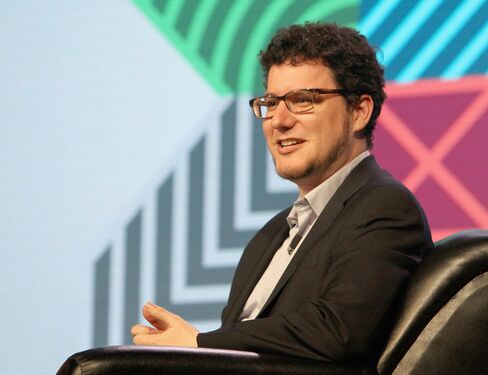The author of "The Lean Startup" and his team are in early talks with the Securities and Exchange Commission
Five years ago, when Eric Ries was working on the book that would become his best-selling entrepreneurship manifesto "The Lean Startup," he floated a provocative idea in the epilogue: Someone should build a new, “long-term” stock exchange. Its reforms, he wrote, would amend the frantic quarterly cycle to encourage investors and companies to make better decisions for the years ahead. When he showed a draft around, many readers gave him the same piece of advice: Kill that crazy part about the exchange. "It ruined my credibility for everything that had come before," Ries said he was told.
Now Ries is laying the groundwork to prove his early skeptics wrong. To bring the Long-Term Stock Exchange to life, he's assembled a team of about 20 engineers, finance executives and attorneys and raised a seed round from more than 30 investors, including venture capitalist Marc Andreessen; technology evangelist Tim O’Reilly; and Aneesh Chopra, the former chief technology officer of the United States. Ries has started early discussions with the U.S. Securities and Exchange Commission, but launching the LTSE could take several years. Wannabe exchanges typically go through months of informal talks with the SEC before filing a draft application, which LTSE plans to do this year. Regulators can then take months to decide whether to approve or delay applications.
If all goes according to plan, the LTSE could be the stock exchange that fixes what Ries sees as the plague of today's public markets: short-term thinking that squashes rational economic decisions. It's the same stigma that's driving more of Silicon Valley's multi-billion-dollar unicorn startups to say they're not even thinking of an IPO. "Everyone's being told, 'Don't go public,'" Ries said. "The most common conventional wisdom now is that going public will mean the end of your ability to innovate."
Eric Ries
To Ries, 37, the public markets encourage self-destructive behavior, and he sees their dynamics as one reason why the number of U.S. public companies has fallen by half since its peak in 1996. Once companies go public, employees “are on Yahoo Finance every day, and it’s palpable how much that is affecting the decision-making of ordinary managers,” he says. The problem begins with stock market investors who favor companies that show big increases in sales, profits, users, or other measures every quarter. When a company falls short, investors flee, and the stock plummets. Managers, hoping to avoid such jolts, spend too much time focusing on short-term performance. Ries said he's heard the same story many times: halfway through a quarter, an executive realizes the company isn’t on track and starts slashing innovative projects to meet the targets.
Ries's seminal book preached a fail-fast method of building startups where teams get a "minimum viable product" in front of customers as quickly as possible to avoid wasting time and effort. "The Lean Startup" made Ries, who previously worked as a software engineer at the failed virtual world maker There and as a cofounder of the more successful social network IMVU, a revered name among Silicon Valley entrepreneurs. While readers flocked to his startup lessons, no one picked up his stock market proposal -- it was too polarizing. When he decided to do it himself, he started talking to bankers, venture capitalists and regulators, who told him his idea was ridiculous. "People treated me like a barbarian," he says. Undeterred, he spent three years recruiting a team and weighing different ideas, such as charging higher fees for short-term trades. Eventually, the LTSE settled on three reforms that address how executives are paid, how companies and investors share information and how investors vote.
A company that wants to list its stock on Ries’s exchange will have to choose from a menu of LTSE-approved compensation plans designed to make sure executive pay is not tied to short-term stock performance. Ries complains that it’s common to see CEOs or top management getting quarterly or annual bonuses tied to certain metrics like earnings per share, which pushes them to goose the numbers. Ries wants to encourage companies to adopt stock packages that continue vesting even after executives have left the company, which will push them to make healthy long-term moves.
The LTSE also wants to nudge companies and investors to share more information, such as detail on R&D spending. To get investors to participate, the exchange has to tempt them with a reward, so LTSE plans to use voting rights as a carrot. If investors divulge the real name of the beneficial owner to management (as opposed to hiding behind a "street name") they'll start to gain more voting rights the longer they've held their shares. LTSE hopes to make money mostly by selling software tools to companies and collecting listing fees, which could be a tough business, given most companies list on either NYSE or Nasdaq in the U.S. and often choose based on a trusted reputation. As Ries sees it, an LTSE-listed company will have an extra stamp of approval. “You’re advertising to the markets that you’re willing to be held to a higher standard,” Ries says. “This is the gold standard, the most long-term, the most hardcore version of going public.”
Ries’s reforms may not have the intended effects. For example, granting stronger voting rights to long-term shareholders would make takeovers harder, and that could end up protecting complacent managers, says Larry Harris, a professor of finance and business economics at the University of Southern California business school. “The threat of takeover has done far more to get good behavior out of corporations than perhaps anything else,” he says. "I suspect a sophisticated investor may shun” an exchange that creates obstacles to investors who want to shake things up.
Getting SEC approval can also be a painful process, especially when trying to change the status quo. Like Ries, Brad Katsuyama, a hero of Michael Lewis's 2014 book, "Flash Boys," is trying to address what he sees as the shortcomings of existing markets. Katsuyama has spent the better part of a year trying to get SEC approval for the Investors Exchange, which he says neutralizes high-frequency traders' unfair advantage. Incumbents aren't happy. NYSE slammed the proposal as "unfair" and "opaque" in a November letter to regulators. Nasdaq last month warned the SEC that if it approved IEX's application, a lawsuit challenging the decision would likely succeed. "Any time an exchange wants to do something significantly different, it's likely to come under a lot of scrutiny and take a long time," said Tyler Gellasch, executive director of investor trade group Healthy Markets.
And while Silicon Valley has successfully overturned many major industries, it hasn't had any luck with entrenched Wall Street traditions. Google's 2004 attempt during its IPO to distribute its shares more equitably via a "Dutch" auction led to a disappointing first day of trading and never caught on. Marc Andreessen sees Google's unorthodox IPO as "a great case study and a cautionary tale," he said. "A big part of what Eric's trying to do is make sure that obviously doesn't happen."
If Ries gets the go-ahead from the SEC, he will face what may turn out to be his biggest challenge: persuading a company to be first to list on LTSE. Since it could be years before the LTSE gets SEC approval, Ries isn't courting Uber, Airbnb or its peers. Instead he’s connecting with mid-size startup founders, some of whom have invested in the LTSE. In the next few years, Ries hopes a handful of these companies will emerge as strong IPO candidates. If he’s lucky, one will be confident enough to be a pioneer. “There’s a real collective action problem here,” he said. “As an industry, we all want to see these changes happen, but there’s always a little bit of an incentive for any individual actor to say, this isn’t my fight – I’ll wait and let somebody else take it on. I don’t begrudge those people. But if everyone does that, change doesn’t happen.”






